| Author |
Message |
|
Adam Simmonds
Location: Henley On Thames Joined: 10 Jun 2006
Posts: 169
|
 Posted: Mon 14 May, 2007 7:23 pm Post subject: handling 19th C. sabres Posted: Mon 14 May, 2007 7:23 pm Post subject: handling 19th C. sabres |
 |
|
hi there,
I'm interested in hearing from anyone's experiences handling/ cutting with various 19th century sabres, particularly the British 1821 light cavalry pattern, as it is a pattern which i find especially attractive and hope to acquire at some stage.
I would be particularly interested in hearing from people with numerous pieces in their collection, in order to get an understanding of the relative merits of different pieces.
thanks, adam s.
|
|
  |
 |
|
Jonathan Hopkins
|
 Posted: Mon 14 May, 2007 8:57 pm Post subject: Posted: Mon 14 May, 2007 8:57 pm Post subject: |
 |
|
Adam,
The 1821 Cavalry Officer's Sword witnessed a change in blades in th eearly 1840s. From 1821 until the early 1840s, the blades were of so-called pipeback form. Then the "Wilkinson" blade became prevalent--a blade with one wide fuller and a flat back. The trooper's version was a more standard blade and did not feature a pipeback blade. Do you have a preference for one or another?
I have never cut with my swords, but I can tell you that the pipeback 1821 is amazingly light and agile, especially for a long cavalry weapon (~35"). Mine as a yelman (middle eastern style false edge) that makes the blade, IMO, especially attractive. I have an 1821 Royal Artillery Officer's sword which is basically the same as a cvalry sword, but shorter like an infantry sword (~32"). The blade on the RA officer's sword is of the "Wilkinson" style, and the sword bestows a certain confidence in the hand.
1821 Officer's swords are more common with the later wide-fullered blade style, and are therefore usually less expensive. The pipebacked blade are earlier, and quite attractive, but are less common and more expensive. The pipeback was replaced due to changes in fashion, but also because of complaints from the field. The wide fullered blade was apparently sturdier, and enjoyed a long service life as it was not replaced until the Pattern 1912 Cavalry Officer's Sword came along.
It is almost bedtime, so I hope I made sense! The Antique & Military subforum at www.swordforum.com is also a good place to look for answers. Do you have any books on the subject? Brian Robson's Swords of the British Army is excellent, and considered the bible of British military swords. The trick is finding a copy and having the money to buy it!
Best,
Jonathan
1821 Light Cavalry Officer's Sword c.1840 with pipeback blade:


1821 Royal Artillery Officer's Sword c.1863


|
|
  |
 |
|
Adam Simmonds
Location: Henley On Thames Joined: 10 Jun 2006
Posts: 169
|
 Posted: Mon 14 May, 2007 10:34 pm Post subject: Posted: Mon 14 May, 2007 10:34 pm Post subject: |
 |
|
hi there,
thanks for the info Jonathan, and congratulations on a most impressive collection.
I have just been browsing your pics through the link you provide. I was particlularly impressed by the condition of many of the blades, which seem to have been very well preserved indeed. Have you had them cleaned or are you just a very discerning buyer?
I was very interested to learn about the different blade types fitted to the 1821 hilt - particularly as i was able to seperately
examine two of these types within the last few months myself and was unsure of the precise differences between and
historical reasons for the variation in blade types. One of them was the pipe back blade while the other, which i came across in a secondhand bookshop, was i think identical to your artillery officer's version (but with much heavier patina) as it didn't seem much more then 30 inches in length.
Being somewhat of a simpleton myself, I am particularly fond f the simpler lines and construction of the wilkinson blade, though both types are excellent examples of the beauty and practicality of the 19thC. sabre.
With reference to the 1912 pattern - was this designed as an exclusively thrusting blade? I handled one at a recent arms fair which seemed very hilt heavy and about as lively as a four by two.
cheers, adam s.
|
|
  |
 |
|
Jonathan Hopkins
|
 Posted: Tue 15 May, 2007 10:02 am Post subject: Posted: Tue 15 May, 2007 10:02 am Post subject: |
 |
|
Adam,
Thanks! 
Re: blade condition, I have not cleaned/polished any of the blades. I have been able to acquire pretty clean examples for the most part. There are some that are not posted that are not as nice, though. I have tried to just maintain the swords rather than "improve" them. Unless the structural integrity of a piece is at risk, I leave it alone.
The later fullered blade is more accessible in terms of availability and pricing. If you are planning on getting one to use for occasional cutting, I recommend finding one that is perhaps more of a run-of-the-mill example. I mean one that is not in pristine condition nor in relic condition; one that does not have a known and storied provenance. (That is the antique collector in me talking!) Trooper's versions are less common as they were in service between 1821 and 1853-ish. They also tend to be in rougher condition, so I don't recommend getting one of these if you intend to do cutting. A later Victorian officer's version should be relatively easy to find. If you need any links to dealers, send me a PM.
The 1912 is the officers' version of the 1908 trooper's sword. It was designed primarily as a thrusting weapon, although the blades could certainly be sharpened along the true edge. I have not handled one in quite some time (14 years!), so I cannot recall how it felt in the hand. Knowing it was a thrusting weapon, would that change your impression? Some consider it to be the "finest sword ever made"--the culmination of over a century of experimentation (between 1788 and 1908, British cavalry troopers went through over ten patterns of swords (more like 12-14, I can't recall exactly at the moment) in 120 years, with many of the patterns emerging towards the end of the 19th century and with minor variations.
Very clean examples of this Pattern (1908/1912) can still be had. Dealer prices tend to be around the $600 USD mark for a trooper's sword. 1821's can vary greatly in price depending on age, provenance and, of course, condition. There are reproductions of the 1821 and 1908/1912 available as well. I am not sure of quality (www.militaryheritage.com). I know Windlass manufactures military swords, and made their first contract with the MoD in 1940. In fact, I believe they own and use some equipment that belonged to Wilkinson (19th century equipment that saw continued use to the present!). If you have look at www.oldswords.com you can search their database for more examples of 1821s.
I hope I was helpful and not too rambling and/or repetitive. I have written this response over the course of the morning and afternoon in between meetings!
Best,
Jonathan
PS--Paging Bill Goodwin...
Last edited by Jonathan Hopkins on Tue 15 May, 2007 8:35 pm; edited 1 time in total
|
|
  |
 |
|
Adam Simmonds
Location: Henley On Thames Joined: 10 Jun 2006
Posts: 169
|
 Posted: Tue 15 May, 2007 3:15 pm Post subject: Posted: Tue 15 May, 2007 3:15 pm Post subject: |
 |
|
thanks Jonathan,
i've been loking at the 1821's displayed at old swords and it seems there are quite a few differnet blades attached to this type.
i have been interested in purchasing a 1821 for some time now just haven't got round to it with available funds as yet. Unfortunately, other more pressing yet less exciting things tend to absorb my financial resources!
I will PM you for some dealer's information though as i would like to get to know what's available and for how much.
I definitely have a preference for the wilkinson style blade in the 30 -33.5 inch range as i don't have a horse. 
regarding the 1912 pattern (or perhaps it was the 1908 i handled? not sure) it was a very well built and solid seeming sword, yet seemed designed for very specialised role - that of being held steady, point forward as one bears down on a rival horseman perhaps, not at all designed for agility and manouverability IMO. Calling it 'the finest sword ever made' (it was also described to me in this way - perhaps a common myth) is, in my opinion, a silly statement to make about any sword and in this case probably the result of flawed linear thinking more then anything else (ie - because it is the newest it is therefore most highly evolved and therefore best). I do not doubt that it was an excellent tool in the role it was designed for - basically as a short lance used from horseback- however i reckon outside of that context, particularly on foot - it would've been clumsy and dangerous to use against a quicker blade.
When someone makes such a claim as "this is the best type of sword ever made", what can one do but smile politely? or, though perhaps not advisable with highly flammable types, gently remark that 'my friend, it is not improbable that you are mistaken. Yet why insist on the truth?' for not even the sharpest blade will cut through some folks' assumptions and it is of no beneift to dull one's patience against such opinions. 
cheers, adam s.
Last edited by Adam Simmonds on Wed 16 May, 2007 3:00 am; edited 2 times in total
|
|
  |
 |
Gordon Frye

|
 Posted: Tue 15 May, 2007 9:44 pm Post subject: Posted: Tue 15 May, 2007 9:44 pm Post subject: |
 |
|
Adam;
While I certainly prefer the elegance and feel of the 1821 sabre, the Patter 1908 has a certain style to it that is rather striking in and of itself. I don't own one, but I do own the American equivalent, the M1913 so-called "Patton Sabre". Both were designed specifically around the thrust, and for using it more as a lance than a sword during the charge. One of the things that then-Lt. Patton states in his Manual of the Sword is that there is no reason for parrying with the weapon. You should be going at your enemy at speed, using the point, and by the time you are able to parry and repost you should be far beyond your enemy's reach, and he yours. He felt that there was no point to the cavalry melée, but that once through the opposing lines, your unit should reform and have another go at the enemy's line.
Well, he had about as much experience at war at the time he wrote that as I do, so we can take it that he had "ideas" that perhaps his grandfathers would have argued with. (I figure if you want to use a lance, use a lance, better yet a pistol. A sword should be more versatile.) Never the less, it seems to be similar to the British point of view for their swords, since they are remarkably similar in construct and intent.
Here's a site for Patton's Manual of the Sword: http://www.pattonhq.com/pdffiles/saberexercise.pdf
Cheers!
Gordon
"After God, we owe our victory to our Horses"
Gonsalo Jimenez de Quesada
http://www.renaissancesoldier.com/
http://historypundit.blogspot.com/
|
|
    |
 |
|
Adam Simmonds
Location: Henley On Thames Joined: 10 Jun 2006
Posts: 169
|
 Posted: Wed 16 May, 2007 3:23 am Post subject: Posted: Wed 16 May, 2007 3:23 am Post subject: |
 |
|
hi Gordon,
what you say about the use of the 1912 sabre certainly rings true and confirms my own impressions based on a brief examination of one myself. As a kind of lance, I think it would have had advantages over actual lances due to its being easily stowable when not needed, freeing one's hands for other things (ie pistols).
What i especially liked about the one i saw was the condition it was in and the fact that it looked to me quite modern, despite being pre WWI. The fact that the overall furniture and pattern appears relatively contemporary is, IMO, a great aspect of this pattern as it is our nearest connection to the time of the sword as an active component of the western military tradition, and in this sense represents the final expression of a long and proud history.
cheers, adam s
|
|
  |
 |
William Goodwin

|
 Posted: Wed 16 May, 2007 5:49 am Post subject: Posted: Wed 16 May, 2007 5:49 am Post subject: |
 |
|
'ello Adam,
Looks as though Jonathan H. (page answered  is answering your enquiries well enough. I'll just toss in is answering your enquiries well enough. I'll just toss in
a few notes from my experience. Don't have a P1821 L-C in my collection, but hope to some day. What I do have in my vintage collection that I've cut with is my British P1821 heavy cavalry (c.1887) and my 1861 Austrian infantry sabre.
The Austrian is a better cutter. The Brit is a field service issue & has been well used. It still has the original f /s edge to it, so I don't mess with trying to sharpen it further. The same with the edge on the Austrian. Both handle quite nicely.
I'll provide a few photos.
Also I agree, Jonathan has quite a nice selection (envy...envy)
Cheers,
Bill
notes ( 1st pic is how the Brit h-c cuts - 2nd pic is part of my vintage collection from top to bottom -
P1897 British infantry officers George V cypher c. 1917, P1821 British Heavy Cavalry c. 1887, 1861 Austrian infantry sabre, and one of my M1902 US Army dress sabres)
 Attachment: 72.92 KB Attachment: 72.92 KB
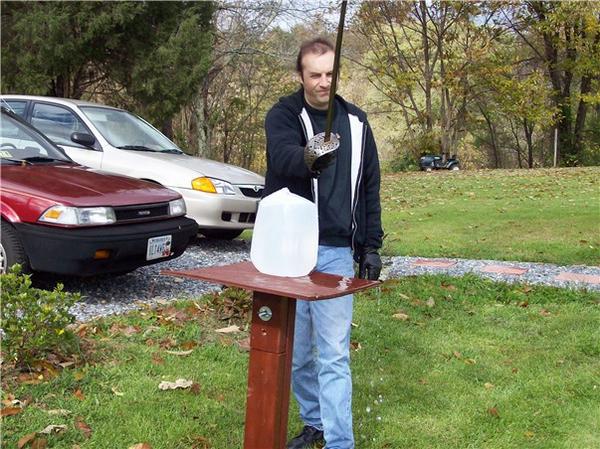
 Attachment: 52.7 KB Attachment: 52.7 KB
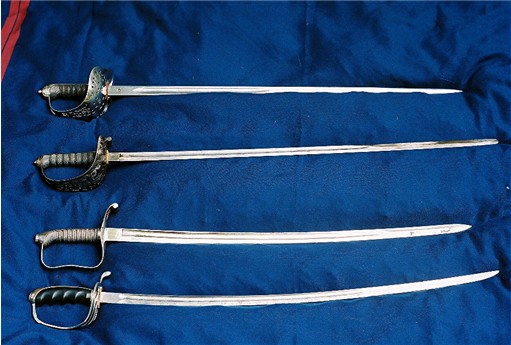
Roanoke Sword Guilde
roanokeswordguilde@live.com
"I was born for this" - Joan of Arc
|
|
   |
 |
|
Vadim Palshin
|
 Posted: Wed 16 May, 2007 9:49 am Post subject: How good are the MH replicas of these sabers? Posted: Wed 16 May, 2007 9:49 am Post subject: How good are the MH replicas of these sabers? |
 |
|
Hi everyone! This post may be slightly off-topic, I apologize if this is the case: Military Heritage seems to be about the only supplier of 19c repro sabers. They look OK, but can anyone comment on their handling compared to the originals? I am looking for a good (inexpensive) replica to study period fencing (starting with the Burton manual), and eventually do some test cutting of soft targets. Currently I am trying to choose between these:
Pattern 1822 Light Cavalry Trooper's Sabre, 31 1/4 inch blade
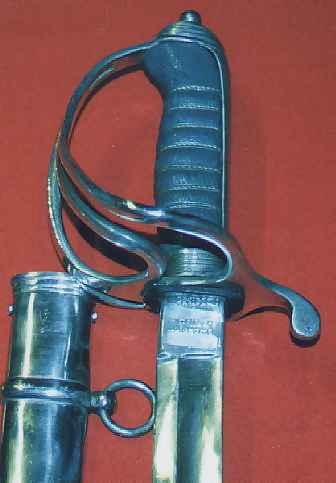
19th Century Royal Artillery Officer's Sword, 34 inch blade (longer than the 1882 cavalry above?  ) )
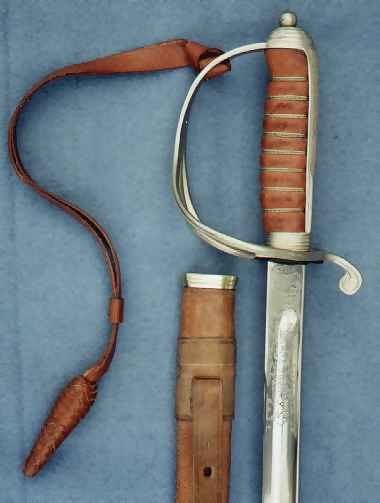
1897 Pattern Infantry Officer's Sword, 32 inch blade
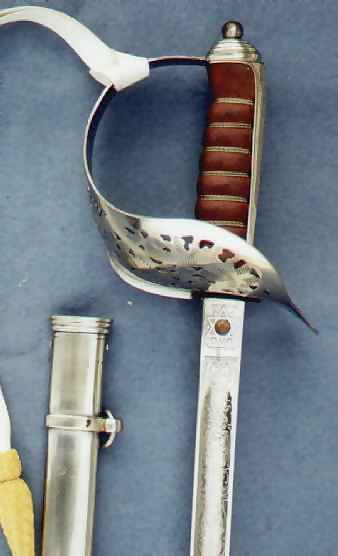
and maybe this one: Infantry Officer's Sabre

The web page does not specify the weight or POB of the blades, and even the length measurements seem suspicious  . Could anyone tell me if any of these swords is light/balanced enough for my purposes, or point me to a good review? I'll appreciate any advice! . Could anyone tell me if any of these swords is light/balanced enough for my purposes, or point me to a good review? I'll appreciate any advice!
|
|
  |
 |
|
Peter Bosman
|
 Posted: Wed 16 May, 2007 12:11 pm Post subject: Posted: Wed 16 May, 2007 12:11 pm Post subject: |
 |
|
Buenas Bill,
I see in your 'avatar' a picture of a mortuary hilt. Now if that is the backsword type, that would not be all thát different from a sabre would it?
Peter
|
|
 |
 |
William Goodwin

|
 Posted: Wed 16 May, 2007 12:56 pm Post subject: Posted: Wed 16 May, 2007 12:56 pm Post subject: |
 |
|
'ello Peter,
In a way yes and in a way no.
(BTW asking me about mortuarys.....you've opened a big can of worms ...have alook at my profile to see why)
Back to the question.......yes, that mortuarys can be viewed as an ancestor to the 19th c. military sabres. as they were mainly carried by cavalry officers of the ECW. Mortuarys were fitted with straight single & double edged blades.
no, in that some see "sabres" are considered as having curved blades.
A straight blade and a curved blade will handle a bit differently in a cut.
Cheers,
Bill
Roanoke Sword Guilde
roanokeswordguilde@live.com
"I was born for this" - Joan of Arc
|
|
   |
 |
|
Jonathan Hopkins
|
 Posted: Wed 16 May, 2007 1:18 pm Post subject: Posted: Wed 16 May, 2007 1:18 pm Post subject: |
 |
|
I can't comment on the functionality or quality of the swords from Military Heritage. The dimensions seem like they should be reversed regarding the 1821 Light Cavalry Sword and the 1821 Artillery Officer's Sword, with the cavalry sword having the longer of the two blades. The 1897 Infantry Officer's sword is more of a thrusting sword, and can only be sharpened for about the last 1/3 of the blade, so If you want a sword for cutting the 1897 would not be the one to get.
On a separate note, the regrettable thing about the swords from Military Heritage is that they are not maker marked. This makes them easy to age and try to pass-off as antique. Many collectors are aware of this, but someone who is new to the field may not notice until it is too late. The Military Heritage pieces tend to be blockier and chunkier than originals, and they use a brown leather for some of the grips that would not be found on most original pieces. The etching is also not of the same quality as an original.
That being said, for those who wish to purchase a replica of a 19th century military sword, there are not many other options, and MH is pretty affordable.
Jonathan
|
|
  |
 |
|
Adam Simmonds
Location: Henley On Thames Joined: 10 Jun 2006
Posts: 169
|
 Posted: Wed 16 May, 2007 1:28 pm Post subject: Posted: Wed 16 May, 2007 1:28 pm Post subject: |
 |
|
hi there Wiiliam,
thanks for the input and photos of your excellent collection.
that 1897 pattern infantry officers sabre you show looks very similar to the type which has been used up till very recently as the standard dress sword for the nz army. For this reason, there are a number of relatively new and affordable examples available. Do you know if the recent dress sword type (made by wilkinson) is solid and sturdy ie potentially servicable - or are the more recent examples just made for show?
cheers, adam
|
|
  |
 |
|
Jonathan Hopkins
|
 Posted: Wed 16 May, 2007 1:48 pm Post subject: Posted: Wed 16 May, 2007 1:48 pm Post subject: |
 |
|
Wilkinson made serviceable swords up until the end. IMO you probably can't go wrong with one! Just remember that only the last 1/3 of the blade can be sharpened due to its design (i.e. a dumbbell cross section). It was designed around the thrust as many later military swords were.
Jonathan
|
|
  |
 |
|
Peter Bosman
|
 Posted: Wed 16 May, 2007 3:09 pm Post subject: Posted: Wed 16 May, 2007 3:09 pm Post subject: |
 |
|
| William Goodwin wrote: | no, in that some see "sabres" are considered as having curved blades.
|
...even though quite a few are straight 
but yes I get the point.
Gaspard de Saunier in his book (1748) deals with two swords for mounted action
1. what we now call a smallsword (epee)
2. what we now call a sabre (sabre)
His illustration of a sabre is an archetypical sabre blade with an almost swepthilt design.
Being banned from France because duels resulting in deaths and seasoning in various wars of his time I talke him as a practical source 
He spent the largest part of his life under Dutch 'royal' patronage. The exáct same ones that may have brought the mortuary hilt sword to the british isles 
Peter
|
|
 |
 |
|
Peter Bosman
|
 Posted: Thu 17 May, 2007 12:21 am Post subject: Posted: Thu 17 May, 2007 12:21 am Post subject: |
 |
|
| William Goodwin wrote: | | Back to the question.......yes, that mortuarys can be viewed as an ancestor to the 19th c. military sabres. |
Another angle to look from is the seljuk and later mamluk sword.
This is an example from the 15th century that sold for 60K GBP in 2005....

The translation of the illustrated 14th century mamluk 'manual' I am reading shows 14 swords and nóne have a real curve. Most are depicted with a straight back and one looks most like a straight double edged type XX.
All have 'normal' pommels and only one the 'bent' form we associate with mamluk swords.
Peter
|
|
 |
 |
|
Jonathan Hopkins
|
 Posted: Thu 17 May, 2007 8:50 am Post subject: Posted: Thu 17 May, 2007 8:50 am Post subject: |
 |
|
Maybe this can be a new thread...
Peter,
Do you have photos of straight sabers? Why differentiate between a backsword or single-edged sword and a saber if there is no difference? I have not seen a straight bladed sword that I would consider a saber. Maybe it is semantics, or my own notion of what makes a saber a saber. For me, if it has a straight blade, it is not a saber. For example, I have seen the US M1913 cavalry sword referred to as the "Patton Saber". I would probably use the term Patton Sword instead since "saber" implies a curved cutting sword in my mind. I would not consider a mortuary-hilted backsword to be a saber., either. I would love to hear some more perspectives on this.
Maybe another thread topic as well, but...
I consider the mortuary hilt to be distinctly English. I would not disagree that it is a close relative of the walloon hilt, and that it may have Continental origins. However, the mortuary hilt--not including the so-called proto mortuary hilt-- is distinct from the walloon (e.g., walloons have bilobate guards) and I have not seen the mortuary style hilt attributed to any other country. The walloon style hilt may have influenced the development of the mortuary, but I do not believe that the English borrowed or took the mortuary from Europe--they simply improved on another design  . .
Thanks,
Jonathan
Added: for reference, here is the US M1913 Cavalry Sword:

|
|
  |
 |
William Goodwin

|
 Posted: Thu 17 May, 2007 9:28 am Post subject: Posted: Thu 17 May, 2007 9:28 am Post subject: |
 |
|
Yes Jonathan............"There is a Santa Cla."........wait....wrong story...............
The Mortuary is "strictly" English by all means.....no other ...........
Bill
Roanoke Sword Guilde
roanokeswordguilde@live.com
"I was born for this" - Joan of Arc
|
|
   |
 |
|
Peter Bosman
|
 Posted: Thu 17 May, 2007 11:26 am Post subject: Posted: Thu 17 May, 2007 11:26 am Post subject: |
 |
|
| Jonathan Hopkins wrote: | Peter,
Do you have photos of straight sabers? Why differentiate between a backsword or single-edged sword and a saber if there is no difference? I have not seen a straight bladed sword that I would consider a saber. Maybe it is semantics, or my own notion of what makes a saber a saber. For me, if it has a straight blade, it is not a saber. For example, I have seen the US M1913 cavalry sword referred to as the "Patton Saber". I would probably use the term Patton Sword instead since "saber" implies a curved cutting sword in my mind. I would not consider a mortuary-hilted backsword to be a saber., either. I would love to hear some more perspectives on this. |
If your perception of a sabre is a curved blade per definition there is obviously no way I can show a picture of a straight bladed sabre 
Yes, it ís semantics.
The 'mamluk sword' has also a specific model in the perception and funnily enough a sabre  This is quite incorect as the mamluks used several type of blades and even the curved 'pommel' is only óne example. Some are sabres, some are more like viking sword, some falchion-like, some yagathan type, some like nothing else. So what ís a 'mamluk sword' that is called a sword but generally ment to indicate the specific sabre-type Napoleon copied. This is quite incorect as the mamluks used several type of blades and even the curved 'pommel' is only óne example. Some are sabres, some are more like viking sword, some falchion-like, some yagathan type, some like nothing else. So what ís a 'mamluk sword' that is called a sword but generally ment to indicate the specific sabre-type Napoleon copied.
My whole point is that he term 'sabre' is not very clearly defined and both includes a type of hilt/guard and a single edged blade. Yes, I would consider the Patton-model a sabre indeed. So thank you for this nice picture of a straight sabre 
Like with most blades, hilt type etc. it is fairly unimportant wether they neatly fit in their assigned boxes or not and Í think one should try to avoid to think in terms of these boxes.
To me the difference between a walloon and a mortuary hilt-type sword is..... well, academic. On the other hand I consider the difference between a double edged and single edged sword to be HUGE even if they both happen to be fitted with the same mortuary hilt.
To put some oil on the english fire I would like to comment that the protestant King William (of Mary) of Schotland and England and whatever was.... Dutch  The 'distance' between the walloon and the velddegen that was used in the Low Countries and the english variety was rather small. The 'distance' between the walloon and the velddegen that was used in the Low Countries and the english variety was rather small.
Anyway, is this important? The differences between hilts of what can be considered to be archetypical sabres by all differ more that the mortuary and walloon 
Like Oakeshott explaines typology is nothing more then a VERY rough framework to help understand the function of swords and their development through time.
So, define 'a sabre' 
My suggestion is to simply provide two or three pictures with the caption 'something like this, meant to be used by mounted men' 
Peter
|
|
 |
 |
|
Jonathan Hopkins
|
 Posted: Thu 17 May, 2007 12:06 pm Post subject: Posted: Thu 17 May, 2007 12:06 pm Post subject: |
 |
|
Peter,
Thanks! It is easy to put things in neat little boxes and assume that everyone else organizes their boxes the same way. I appreciate hearing your perspective on what makes a saber a saber. I don't know if I will ammend my definition, but I will keep yours in mind the next time sabers are discussed. The more perspectives one can see, the better, I guess!
The differences are academic for the walloon and mortuary hilts, I agree.
| Quote: | | On the other hand I consider the difference between a double edged and single edged sword to be HUGE even if they both happen to be fitted with the same mortuary hilt. |
I agree!
Thanks,
Jonathan
|
|
  |
 |
|
|
You cannot post new topics in this forum
You cannot reply to topics in this forum
You cannot edit your posts in this forum
You cannot delete your posts in this forum
You cannot vote in polls in this forum
You cannot attach files in this forum
You can download files in this forum
|
All contents © Copyright 2003-2025 myArmoury.com — All rights reserved
Discussion forums powered by phpBB © The phpBB Group
Switch to the Basic Low-bandwidth Version of the forum
|

